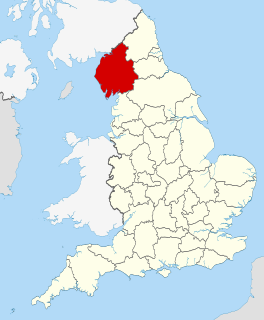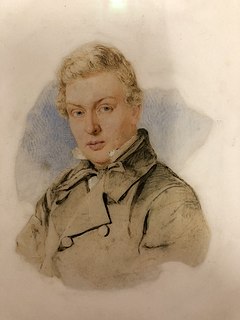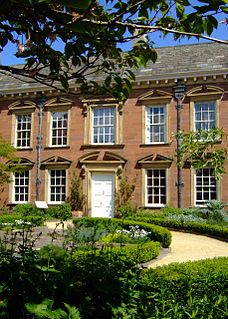Related Research Articles

Cumbria is a ceremonial and non-metropolitan county in North West England, bordering Scotland. The county and Cumbria County Council, its local government, came into existence in 1974 after the passage of the Local Government Act 1972. Cumbria's county town is Carlisle, in the north of the county. Other major settlements include Barrow-in-Furness, Kendal, Whitehaven and Workington.

The Eden Valley Railway (EVR) was a railway in Cumbria, England. It ran between Clifton Junction near Penrith and Kirkby Stephen via Appleby-in-Westmorland.

Brampton is a market town, civil parish and electoral ward within the City of Carlisle district of Cumbria, England, about 9 miles (14 km) east of Carlisle and 2 miles (3.2 km) south of Hadrian's Wall. Historically part of Cumberland, it is situated off the A69 road which bypasses it.
Sheila Fell was an English artist. She was born at Aspatria, Cumberland in 1931. Although she lived in London for the greater part of her life, she devoted her career to painting the Cumberland landscape.

Keswick School of Industrial Art (KSIA) was founded in 1884 by Canon Hardwicke Rawnsley and his wife Edith as an evening class in woodwork and repoussé metalwork at the Crosthwaite Parish Rooms, in Keswick, Cumbria. The enterprise, designed to alleviate unemployment, prospered, and within ten years more than a hundred men were attending classes. A new building was erected for the school at a nearby site.
St Martin's College was a British higher education college with campuses in Lancaster, Ambleside and Carlisle, as well as sites in Whitehaven, Barrow and London. It provided undergraduate and postgraduate courses in the arts, humanities, business studies, teacher training, health and social care. In 2006 the college was granted the power to award its own degrees. On 1 August 2007, the college merged with other institutions to form the University of Cumbria.
The University of Cumbria is a public university in Cumbria, with its headquarters in Carlisle and other major campuses in Lancaster, Ambleside, and London. It has roots extending back to the Society for the Encouragement of Fine Arts, established in 1822, and the teacher training college established by Charlotte Mason in the 1890s. It opened its doors in 2007 as a university.
Anton Hecht is an English artist born in London. In 2007 he asked musicians from around the Durham area to contribute to a soundtrack for a film. In 2005 he was one of seven artists involved in a project to recreate the Cumbrian town of Whitehaven in Lego.

The history of Cumbria as a county of England begins with the Local Government Act 1972. Its territory and constituent parts however have a long history under various other administrative and historic units of governance. Cumbria is an upland, coastal and rural area, with a history of invasions, migration and settlement, as well as battles and skirmishes between the English and the Scots.
The English county of Cumbria is located in North West England and has a population of 496,200. Cumbria has an area of 6,768 km², making the county England's 3rd largest county. With only 73 inhabitants per km², it is the country's second least densely populated county. People from Cumbria are known as Cumbrians and they speak a variety of the Cumbrian dialect to the north, whilst a Lancashire accent is more prominent in the South. Along with Lancashire to the south, Cumbria is bordered with Scotland to the north, the Irish Sea to the west, Northumberland to the north-east, County Durham to the east and North Yorkshire to the south-east.

William James Blacklock was an English landscape painter, painting scenery in Cumbria, the Lake District and the Scottish Borders.
Jenny Cowern (1943–2005) was a visual, multi-media artist, who took inspiration from the natural surroundings of her adopted county, Cumbria, to produce some of the most dramatic and lasting images of nature. An acute observer of the continual change in the natural world, she took light and reflection, growth and decay, beaches and tides, pebbles and stones, clouds and shadows and manipulated them to capture a unique view of her surroundings. In addition to pen and ink, pencil, oils, watercolours, and pastels, a series of commissions enabled her to employ egg tempera murals, architectural designs, and industrial enamelling techniques. Irrespective of the media employed, it was with felt that she produced her most compelling and remarkable work. In the words of lifelong friend Duncan Smith: "Cowern took an ancient craft, pushed it in thrilling new directions and gave us contemporary pieces of the highest order."
Mark Neville is a British social documentary photographer.

Cumbria Museum Consortium is a grouping of museum organisations in Cumbria, north west England, which receives funding from Arts Council England as a "Major Partner Museum".
Paul Robinson, is an English artist and painter, whose work is included in public, corporate and private collections worldwide.
John Darwell is a British photographer.
Hangama Amiri is an Afghan-Canadian feminist artist, who works in painting and video. Amiri's work has been exhibited in Canada in cities including Halifax, Vancouver, Toronto and Lunenburg. Internationally, her work has appeared in New York, London, Hong Kong, Italy, France, Morocco and Venice.
Lorna Graves (1947–2006) was a British artist who worked across a diverse range of media including painting, drawing, printmaking and sculpture. Her artwork was deeply connected to nature, the Cumbrian landscape and ancient cultures.
Mary Elizabeth Burkett OBE (1924-2014) was an English supporter of the arts, especially in Cumbria, the director of the Abbot Hall Art Gallery from 1966 to 1986, and an expert on felt-making.
References
- ↑ "Results of Final Examinations: June 1983". Durham University Gazette 1982/83. 1 (Combined Series): 88. 1983. Retrieved 14 March 2020.
- ↑ Vincent, Alice E. "Derek Eland Installs Afghanistan 'Diary Rooms' To Captures Soldiers' Stories", Huffington Post , 12 October 2012. Retrieved on 26 September 2014.
- ↑ Judd, Terri."The Helmand Project" The Independent , 27 September 2011. Retrieved on 10 May 2020.
- ↑ BBC News May "Soldiers in Afghanistan: In our own words", BBC News, 29 September 2011. Retrieved on 26 September 2014.
- ↑ "Derek Eland: Diary Rooms". mima, November 2014 – May 2015.
- ↑ WNYC Studios."Meet Mount Everest's Artist-in-Residence" 4 January 2016. Retrieved on 10 May 2020.
- ↑ Piskorz, Juliana. "Before the ascent: postcards from everest" The Guardian , 16 April 2017. Retrieved on 10 May 2020.